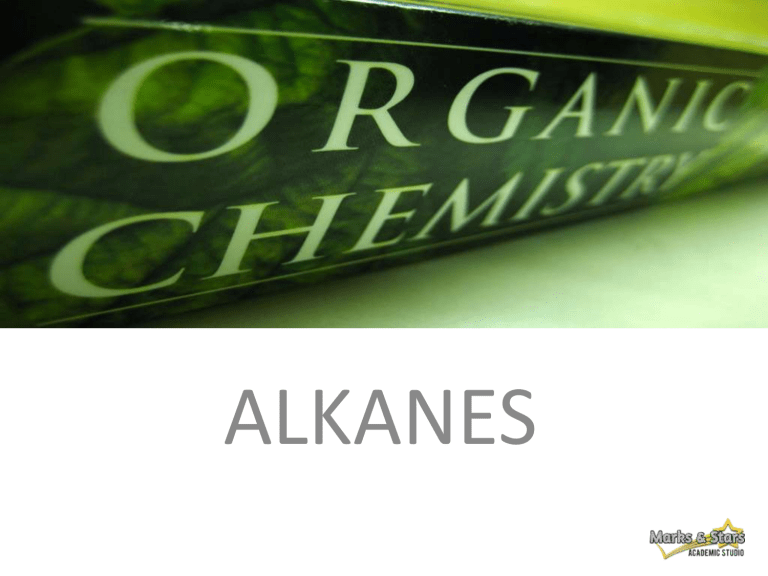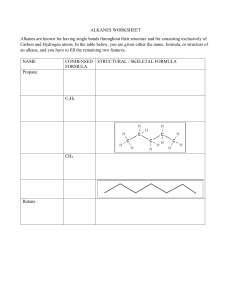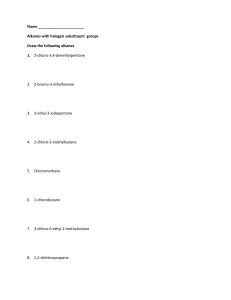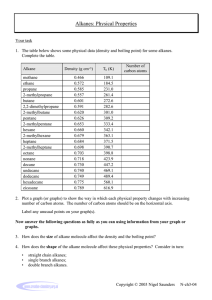
ALKANES Learning outcomes Students should be able to: 1.Describe a homologous series and its general characteristics; 2.Describe the alkanes as a homologous series of saturated hydrocarbons with the general formula CnH2n+2; 3.Draw the structures of branched and unbranched alkanes, C1 to C4 and name the unbranched alkanes C1 to C4; 4.Define isomerism and identify the isomers; 5.Describe the properties of alkanes; HOMOLOGOUS SERIES • There are millions of different organic compounds and chemists have devised a method of classifying them into families with similar formulae and properties. • Each family of organic compounds is called a homologous series. • A homologous series is a family of compounds with the same general formula, same functional group and similar chemical properties. HOMOLOGOUS SERIES HOMOLOGOUS SERIES • The alkanes and alkenes are hydrocarbons (containing hydrogen and carbon only). • The alcohols and carboxylic acids contain carbon, hydrogen and oxygen. HOMOLOGOUS SERIES CHARACTERISTICS • Organic compounds in the same homologous series have the following characteristics: • Same general formula • Same functional group • Similar chemical properties but varying in reactivity • Physical properties vary gradually along the series FUNCTIONAL GROUPS AND GENERAL FORMULA • A functional group is an atom or group of atoms that gives a compound its characteristic chemical properties. • Organic compounds in the same homologous series have similar chemical properties due to the same functional group. • Each member of the series differs from the next by a –CH2- unit. GENERAL FORMULA OF ALKANES? NAMING ORGANIC COMPOUNDS • The name of an organic compound is divided into two parts. • The first part (prefix) tells us the number of carbon atoms in each molecule. • The second part (suffix) tells is which homologous series the compound belongs to Methane Methanol OH Methane Ethanoic Acid COOH WHAT ARE ALKANES? • Alkanes are a homologous series of saturated hydrocarbons that contain only carboncarbon single covalent bonds. • In an alkane molecule, all the outer electrons of each carbon are used in forming single covalent bonds with four other atoms, hence, alkanes are said to be saturated. • Alkanes have the general formula CnH2n+2 (where n ≥ 1) HOW ARE ALKANES REPRESENTED? RULES FOR NAMING ALKANES • Find the longest carbon chain in the compound. This gives the parent name of the compound. 5C 5C 3C RULES FOR NAMING ALKANES • Number each carbon atom in the longest chain, starting from the end nearest to the branch. This means that the number appearing in the name is a smaller number. 5 4 3 2 1 BRANCH RULES FOR NAMING ALKANES • Name the group joined to the chain and state the number of the carbon atom to which it is joined. 2 Methyl Group 2-Methylpentane RULES FOR NAMING ALKANES • If the chain has 2 more identical groups joined to it. Prefixes like di-, tri-, tetra- are used to indicate the number of groups present. 1 2 3 4 5 6 7 Methyl Groups 2,4-Dimethylheptane Two Common Branches Ethyl Group RULES FOR NAMING ALKANES • If a chain has 2 or more different groups joined to it, the groups are written in alphabetical order i.e. ethyl before methyl. 4 –ethyl-2-methylhexane Name this Alkane 2,2-Dimethypropane PHYSICAL PROPERTIES OF ALKANES • Physical states PHYSICAL PROPERTIES OF ALKANES • As the number of carbon atoms in the molecules increases, the melting and boiling points increase. PHYSICAL PROPERTIES OF ALKANES • Generally, alkanes have low melting and boiling points. This is due to the weak intermolecular forces of attraction (van der Waals’ forces) which can be overcome by a small amount of heat energy. • As the alkane molecules become larger (increase in the number of carbon atoms in the molecules, the intermolecular forces of attraction become stronger. More heat energy is needed to overcome the intermolecular forces of attraction to separate the molecules and the melting and boiling points increase. PHYSICAL PROPERTIES OF ALKANES • As the number of carbon atoms in the molecules increases, they become less viscous (flow less easily). • This is due to the stronger intermolecular forces of attraction and • Larger molecules get tangled together easily. PHYSICAL PROPERTIES OF ALKANES • As the number of carbon atoms in the molecules increases, their densities also increase. Liquid alkanes have densities less than 1g/cm3 and they float on water. PHYSICAL PROPERTIES OF ALKANES • As the number of carbon atoms in the molecules increases, they become less flammable (more difficult to burn). • The larger alkane molecules contain a higher percentage of carbon and this makes it more difficult to burn. • The larger alkanes also tend to produce a smokier flame due to incomplete combustion of the alkane molecules. PHYSICAL PROPERTIES OF ALKANES • Alkanes are insoluble in water but soluble in organic solvents such as CCl4. CHEMICAL PROPERTIES OF ALKANES • Alkanes are generally unreactive. • This is because alkane molecules contain single carbon-carbon covalent bonds (C-C) and single carbon-hydrogen covalent bonds (C-H) which are strong and require a lot of energy to break. CHEMICAL PROPERTIES OF ALKANES • Combustion • Alkane + oxygen carbon dioxide + water vapour • CH4 (g) + 2O2 (g) CO2 (g) + 2H2O (g) ∆H = -890kJ/mol • The reaction is highly exothermic and a large amount of heat energy is released. This is why alkanes make good fuels. CHEMICAL PROPERTIES OF ALKANES • Substitution Reactions • A substitution reaction is one in which an atom or group of atoms replace other atoms in a molecule. • It is usually a slow reaction that is difficult to control and a mixture of products is usually obtained. CHEMICAL PROPERTIES OF ALKANES • Reaction is initiated by ultra-violet light which provides the energy to break the covalent bond in the chlorine molecule to produce chlorine atoms. CHEMICAL PROPERTIES OF ALKANES • For instance, methane reacts with chlorine as follows: • This is a substitution reaction because the hydrogen atom in methane has been replaced by a chlorine atom. CHEMICAL PROPERTIES OF ALKANES • More hydrogen atoms can be replaced with chlorine atoms to produce a mixture of four organic compounds as follows: • CH3Cl + Cl2 CH2Cl2 + HCl • CH2Cl2 + Cl2 CHCl3 + HCl • CHCl3 + Cl2 CCl4 + HCl ISOMERISM • Isomers are compounds with the same molecular formula but different structural formulae. • Isomers have different melting and boiling points. • Isomers may or may not belong to the same homologous series. Quiz Summary








